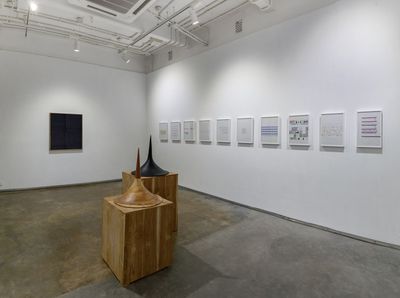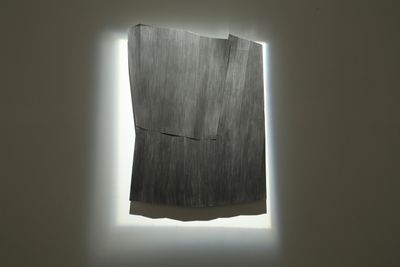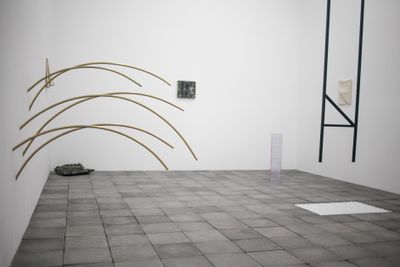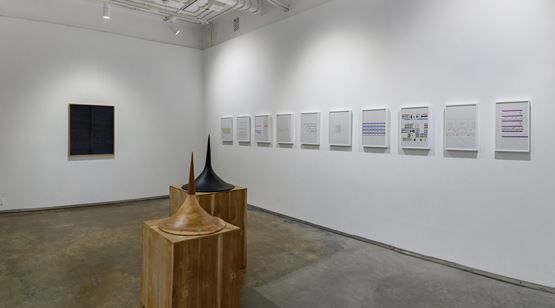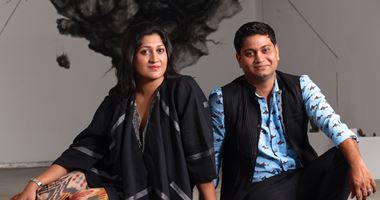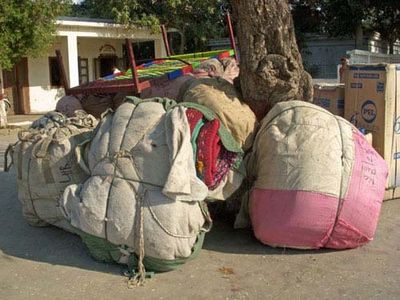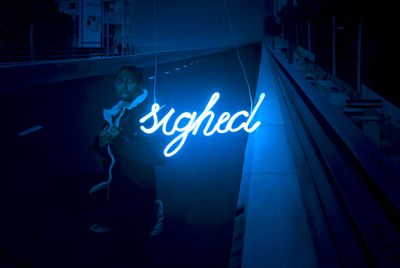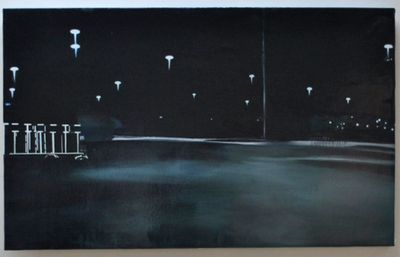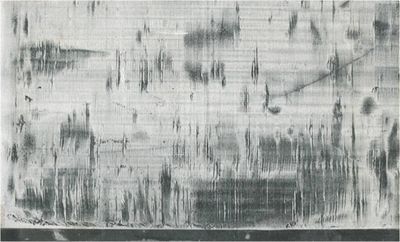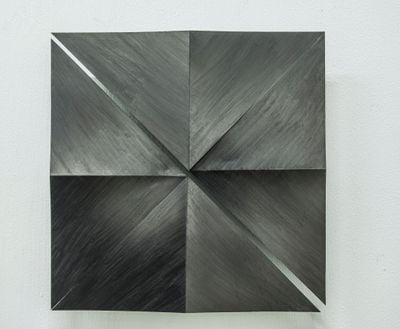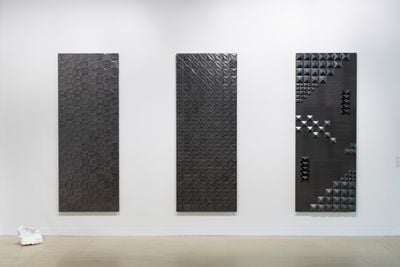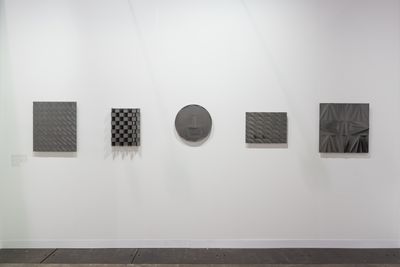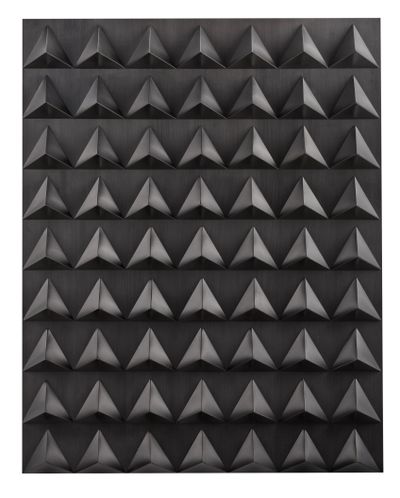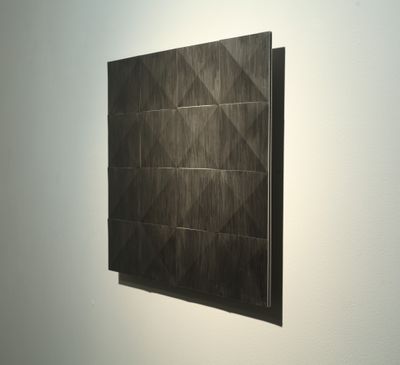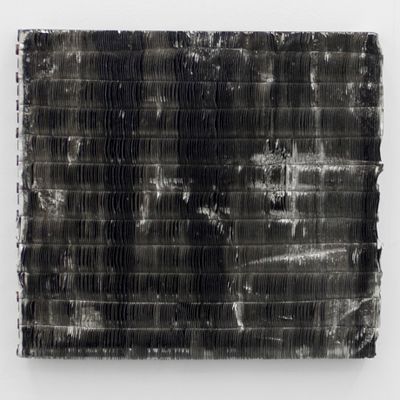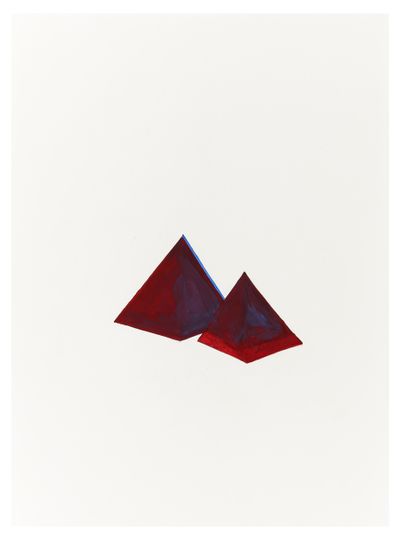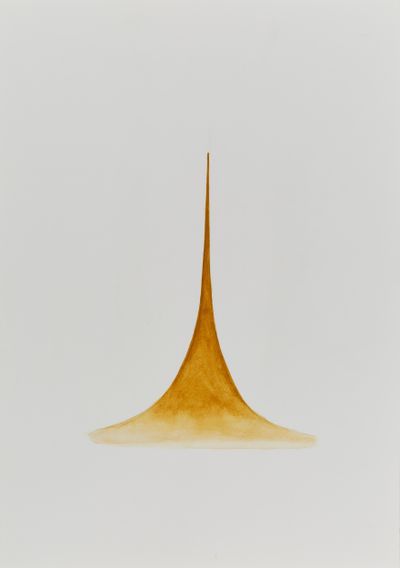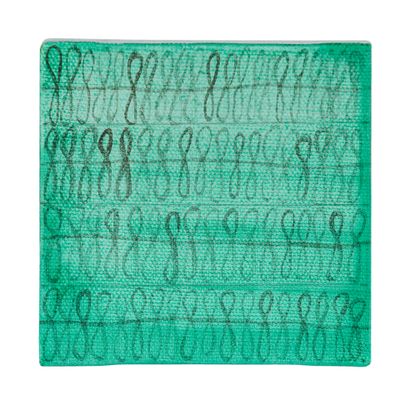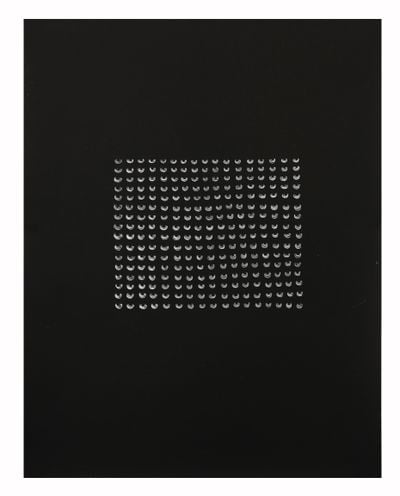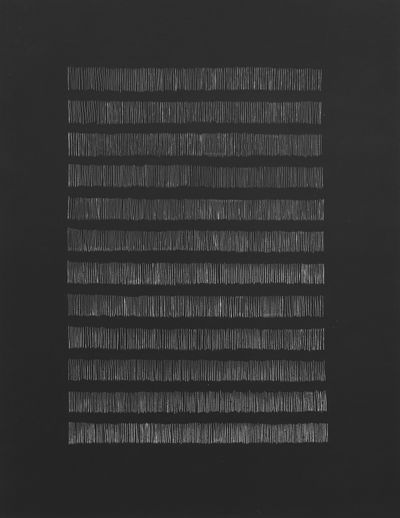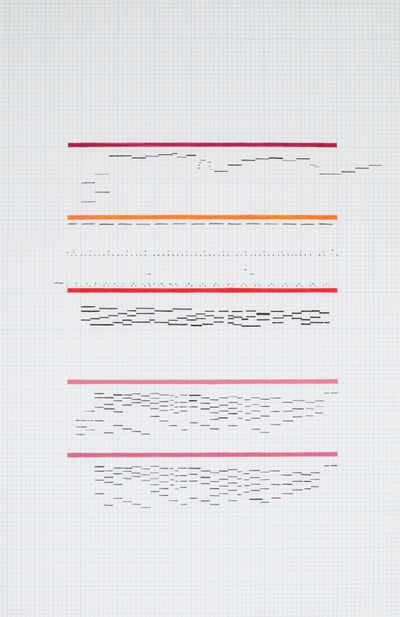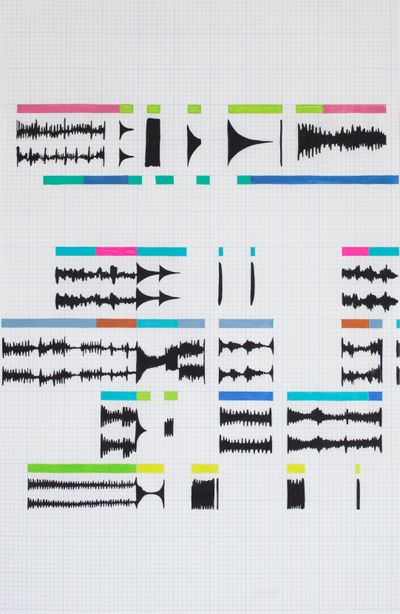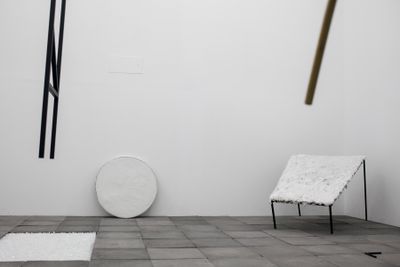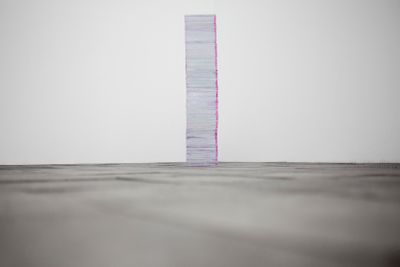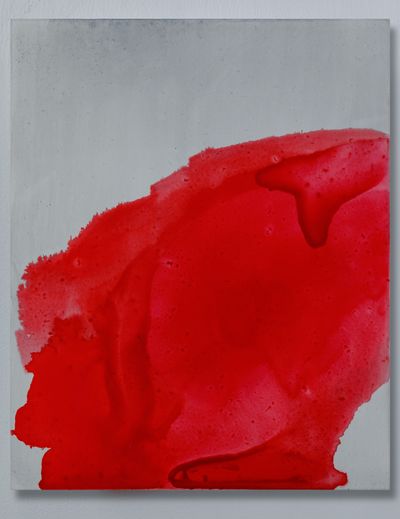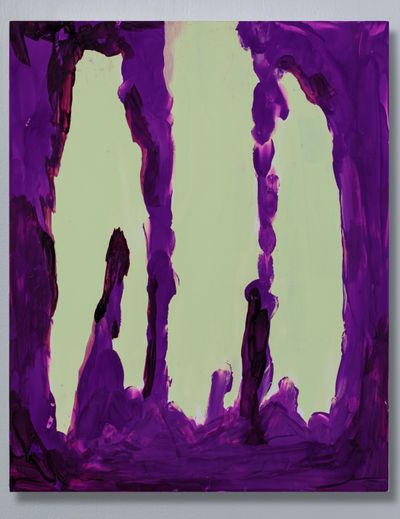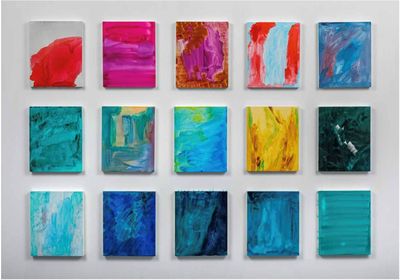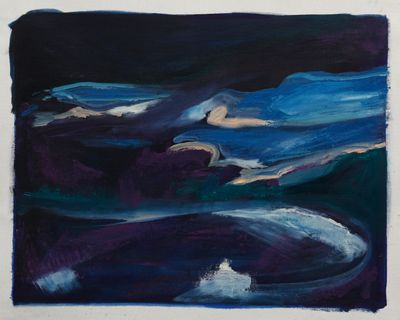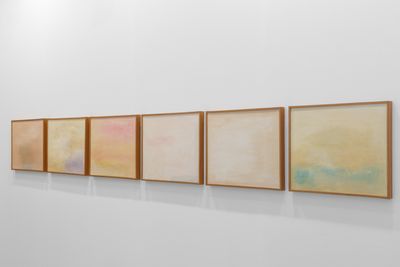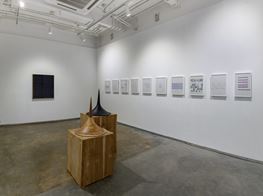Ayesha Sultana’s Intentional Geometries
Ayesha Sultana. Courtesy the artist. Photo: Nabil Rahman.
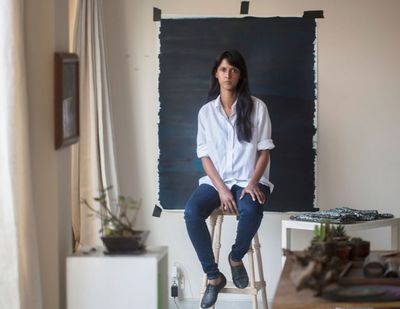
Ayesha Sultana. Courtesy the artist. Photo: Nabil Rahman.
Through acts of folding, cutting, layering, and scratching, Ayesha Sultana investigates the peripheries of vision, making visible what is commonly overlooked.
Her practice is an ongoing investigation of drawing, deriving forms from her surroundings to create an understanding of space. In 2009, the artist returned to Bangladesh, moving to Dhaka after completing her postgraduate diploma from Beaconhouse National University in Lahore, where she also obtained her BFA.
Sultana's graphite relief works, for which her practice is best known, derive from the landscape of Dhaka, looking at capturing shapes in 'windows, niches and gates' through shimmering, graphite-dusted surfaces of paper that are cut and reassembled in geometric forms, before being mounted on dibond paper.
Outside the Field of View (9 May–26 June 2014), the artist's first solo exhibition at Experimenter brought together a series of these works, including Outside the Field of View IX (2014), which references the corrugated tin sheets commonly used for rooves and wall boundaries across Dhaka, with the rhythm of their grooves replicated in the paper of Sultana's work, which has been reassembled at angles to create a play with light.
Repetition and a play with light and darkness activate rhythm and movement in Sultana's work, as seen in A Space Between Things (2015–2016) commissioned for the Dhaka Art Summit (5–8 February 2016). Bringing together a series of sculptures made from materials spanning glass, fabric, stone, plaster, wood, mylar, and metal, the installation's varying forms were activated in the space through the presence of viewers. With a level of precarity emphasised by a glass tower (Pool III, 2016) in the room's corner, Sultana emphasised the fragility of the built environment, with parts of the cement tiles on the floor coming apart and disappearing over the course of the exhibition.
An understanding of material and process is furthered in Sultana's most recent exhibition at Experimenter, titled Pulse (22 August–30 September 2020). Revisiting repetition, Sultana explores the pulse as occupying 'space, time and form' with a series of gouache drawings that capture sonic readings, while tear drop-shaped wooden sculptures atop plinths visually reinterpret the fall of water. The exhibition demonstrates Sultana's ability to move across media to capture the immaterial and the unseen, in a practice that is rooted in process and the act of making.
In this edited transcript of a talk hosted by Experimenter on Zoom on 26 September 2020, Sultana discusses the arc of her practice, along with her recent return to painting after a long hiatus, with Brooklyn and Sharjah-based critic, curator, and art historian, Murtaza Vali.
MVThank you Prateek and Priyanka and the rest of the team at Experimenter for the invitation, and for facilitating this discussion. I know it seems relatively easy, as Zoom has smoothed everything out, but there is a lot of production that happens behind the scenes. So, thank you. I am grateful, and I'm sure Ayesha is as well.
Welcome everybody from around the world—people who have gotten up bright and early like me in North America and also friends and colleagues joining from Europe, the Middle East, and South Asia as well. This is a rare opportunity—we get to hear about Ayesha's work in her own words, so I am very excited and honoured to be invited to facilitate this conversation on all of our behalf and hopefully I'll be able to do justice to Ayesha's amazing work.
South Asian art is, if anything, defined by a maximalist tendency, and so artists who engage with minimalism tend to be rare birds. There are only a handful of people who come to mind immediately—people like Nasreen Mohamedi, Lala Rukh, Zarina Hashmi, and Seher Shah, and, of course, Ayesha, whose graphite relief works have stayed with me since I first saw them about five years ago, and I have followed her practice since.
While Ayesha's practice is driven by an interest in abstraction and minimalism, it is also quite experimental and engages with a variety of materials and processes, and so, hopefully, we're going to try to cover a large arc of her practice through this conversation.
MVAyesha, I'd like to start at the beginning. You studied art and then taught in Lahore at Beaconhouse National University. South Asia is not as open a region as we would like it to be. Cross-border exchanges, more and more so as politics worsen in these countries, are rarities. I have always been struck by the fact that you chose to study in Lahore, so I wanted to start off by asking you why you decided to go to school there, and what your time there was like, as a way of entering into your early practice and works.
ASI arrived in Lahore in a rather indirect way. As I was finishing 12th grade back in 2003, I received a phone call from my school asking whether I might be interested in applying for an arts scholarship recommended by my art teacher back in school, Fareha Zeba. She's a Bangladeshi artist, and the scholarship was actually being provided by the South Asia Foundation, founded by UNESCO Goodwill Ambassador and writer Madanjeet Singh.
The scholarship programme was for two students from each of the SAARC countries, and it felt like a really unique opportunity for me. I remember drawing back then, and I had O-level art, but it was more as a hobby. I could not dream of pursuing it professionally—the idea was quite wild to me. I was nominated and applied for it, and that's how I left. I was part of the first batch.
In 2003, there were no direct flights to Lahore from Dhaka. There was another student travelling with me, Musharrat A. Chowdhury, from the printmaking department at the Fine Art Institute, and after a very long transit, we arrived in Lahore. I remember the first night, we were staying in the residence of Salima Hashmi. I didn't know of her—I actually looked her up online after I received the brochure from Beaconhouse, so that was sort of the beginning.
The visual arts curriculum was very interesting because it was multidisciplinary, with overlaps, so those distinctions between painting and sculpture, for example, were insignificant. We were introduced to different techniques and ideas, and I tried to assimilate some of those experiences.
My first year was quite challenging on some personal levels, but I managed to overcome some of it over the time that I was at BNU. It was a new institute, and we had tutors like Huma Mulji, Sophie Ernst, Julia Ahmad, Mariam Hussain, Farida Batool, and Rashid Rana, so there was this really exciting energy, and it was a very nurturing environment. There was a certain fearlessness that you felt in the presence of, say, Salima Hashmi or Huma Mulji. But I think the special thing about my time in Lahore was the friendships and bonds that I developed, that go beyond my time there as a student.
Initially when I went, the scholarship was being offered just for foundation studies, and there was support from home, especially from my father, who was very supportive from the beginning. Despite our shared history of 1971, he supported the idea of me pursuing this. He was happy, so that really pushed me forward to go to Lahore.
MVHaving spent some time with the arc of your practice, I'm struck by how there are seeds of your later practice in these early works, your interest in geometry and pattern, and an observational interest in spaces and landscapes, as well as luminosity and colour, which I think comes through in your most recent works.
Could you talk a little bit about these early works, and the ideas you were exploring at the time? One thing that does seem to have dropped out of your practice is an interest in text. Maybe you could talk a little bit about that, too?
ASAs a student I was exploring different things, and I remember working on these drawings on paper. They were watercolours looking at interior spaces—kind of psychological interior spaces, but they would have figures in them. For my thesis, I worked on a large-scale painting installation, where I used these figures of people I knew—friends and others with specific kinds of body types. I was photographing them, collaging the images on the computer and putting them in certain landscapes, using different resources—such as magazines or found imagery, sometimes of Dhaka, for instance.
I also used text—the text in that particular work, They sighed a toast of denial (2007), is part of a poem by a friend—to give some context to the idea of the work, as a point of entry. The text was presented in neon and suspended in front of the painting.
Right after my thesis project, I deliberately removed the body, the human form. I don't know if it was a reaction to some of the work that I was making before that. I was photographing gas stations and making drawings of them, just looking at spaces of intervals—places of rest or pause. It seemed quite mundane, but I was interested in the non-event. This is a night scene from a park. It's titled Park (2010).
These are also oil paintings, and I remember going into art school with absolutely no background in painting, and that's something I think I've been unlearning and reflecting upon these days. I've been thinking of going back to painting after a long hiatus of ten years or so.
I was using photographic references or making sketches and collages and juxtaposing the two digitally and using those printouts and grids to work on the paintings. Time was a big factor—maybe that's also one of the reasons I stopped painting, because I would take months to complete a single work, whereas the drawings that came after I moved back to Bangladesh felt freeing and more immediate as an experience or process of working.
Doubles (2012) is an image I took in Lahore—it's a photograph of the back of an air conditioner. Back then, I was taking these photographs, but I didn't really know why I was taking them. And later on, I printed them and made photocopies, xeroxed them, and it's a body of work I've made looking at these kinds of textures in anonymous structures.
MVI think the idea of the non-event or liminal space is really interesting as a metaphor for how one thinks about abstraction and minimalism, because, at least in Western art history, there's this discourse around objecthood, and this famous line by Michael Fried, that 'presentness is grace'. In some sense, the non-eventness, a rejection of narrativity, is an expression of presentness, but it also implies non-presentness.
As I mentioned earlier, your work is quite closely tied to minimalistic aesthetics, which is rare in the South Asian context, so I wanted to ask you a little bit about the origins of your interest in abstraction and minimalism and how it evolved into the graphite drawings that you are best known for.
ASIt's hard to pinpoint, but after my undergraduate project, I was looking more and more at different kinds of space—public and private spaces. I was photographing them, and consciously not including the human form, but the absence of it in space could have a presence of it through a psychological dimension.
Also, I don't know about minimalism, but abstraction came through my drawing practice, which developed over time after I moved back to Bangladesh in 2009. I was working on many things simultaneously, with different types of paper. I love working with paper—I find it versatile and malleable—and other materials such as pens and pencils, or found surfaces like newspapers and magazines.
I was also recently thinking about the time I spent in Italy, between 2011 and 2012. After that experience, my colour palette became more monochromatic, even though I was working in Baroque Rome. I was working with an artist over there, and I would spend the weekends visiting churches and making sketches inside these ancient buildings.
I was also looking at a lot of paintings or making trips—one of my most memorable trips was to Padova, to the Scrovegni Chapel, looking at the panels of Giotto. I was completely blown away. I was also looking at how other artists throughout the centuries have depicted pictorial space. It was a gestational period where I wasn't necessarily making anything substantial, but I was thinking about it.
Also, at Beaconhouse, I do believe Rashid Rana's practice influenced me to an extent. You know, his compositions and the grid, and there were also other peers and my classmates who inspired me. I was also recently thinking about the practice of Muhammad Ali Talpur in Lahore. When I went to Lahore in 2003, I saw his works—the ones with the imagery of popular culture. A few years later I visited his home and came across these works on paper, which I found very intriguing. They were just lines—I couldn't believe you could do so much with just line.
MVThat's a really interesting anecdote, and for me it's revelatory of how our experiences of colour and light are both culturally determined and also relative, because the cliché is that northern Europeans go to Italy to discover colour and light, and for those of us from warmer climates, Italy is like a retreat into monochrome, in some sense.
I'm really interested in your geometric abstractions made out of graphite on paper, which are often cut, folded, and assembled, so there is a shallow depth to them. They seem to transcend mediums, and through that alchemy or metamorphosis they tend to confound our vision. I have spent quite a bit of time in front of these trying to convince myself that they are not metal, and I keep coming back to the idea that they are metal. That's one of the things that keeps bringing me back to these works.
MVI was wondering if you could talk a little bit about the process behind making these works, and what inspired it? What drives this interest in a material transformation of sorts, in producing objects that force viewers to do a double take, to question what they are seeing?
ASThis body of work is quite ambiguous to me, even though I've been working on it for a while now. From a material point of view, the fact that it's just paper and graphite is interesting because it's just two very basic drawing materials.
I believe the use of the hand is important, not just in this work, but overall—it's like marking one's place in the world.
When I started the series, I had this interest in painting—in how to create perspective and depth, so this relationship between the two dimensional and the three dimensional was kind of intriguing to me. At first, I started making these small paper constructions. It started off as folded paper.
Simultaneously, I was doing other things, where I was filling up large sheets of paper with different types of pens, which created their own surface quality or sheen, and their own reflective quality. The folding came first, and then the other aspect of how I treat the paper. It has multiple layers of graphite powder, rubbings, and then sometimes I use graphite sticks for the final coats, and of course I fix it in between with spray. I've also worked with different types of paper over the years. I think each has its own gradations of grey and density and richness, so that's also quite playful to me.
Some of the references that I was using were looking at different architectural elements around me or references of them, such as a window or the corner of an interior space, or the pattern of a gate or window frame, as well as being playful with different shapes. I believe the use of the hand is important, not just in this work, but overall—it's like marking one's place in the world. The works imply space, whether it's folding, unfolding, re-folding, expanding, contracting, and so on, and the material comes alive for me.
I can't control the response from the spectator, but what you just said, that you spent time in front of the work trying to convince yourself that it's not metal—that's part of the process. Since it has multiple layers of graphite, the rubbings create that shiny or polished quality of the whole surface, because it buffs the particles of the dust as well.
MVCan you speak a little more about the role of the hand? I know that you've produced a large body of these works, so lumping them all together under a large rubric or generic description is a little unfair, but does the structure or the pattern come first, and then you colour in the segments individually, or do you prepare a surface that's minimal and uniform and then do the folds?
I guess that's kind of a roundabout way of asking, how interested are you in hiding the trace of the hand? Because the removal of the hand of the artist is an important aspect of American minimalist sculpture.
One of the things I was struck by with your work is how it's about precision and geometry, but it is all hand-crafted. I was wondering if you could elaborate on the handmade aspect of the work.
ASIt's sort of like a union between the outer action and the inner being . . . the inner development. I made quite a large body of these drawings. Sometimes I sketch out an idea or make these small constructions on paper, and I think the process really depends—it's not always one strict methodology.
I was working with much smaller sheets of paper and making constructions and layering it with the graphite, and I realised I ended up wasting a lot of paper in that process, so over the years I've treated the paper first, and then worked on the constructions.
MVHave you experimented with the visibility of the hand, or have you tried to produce a pristine minimal surface?
I recall something one of my professors in graduate school once said, that it is quite hard, as someone who makes things, to erase traces of yourself but still retain the handmade quality. The body always betrays itself. Achieving a pristine minimal surface that's made by hand is quite difficult. I noticed when looking through your work, there are some where the hand is more visible.
Is that something you play with, while you're working with this infinite spectrum of greys?
ASIt depends on the kind of paper I'm using, how many layers of powder I'm applying, and how it's applied. It really depends on the application and sometimes it's more visible—even with the foldings, because the works are all in much smaller sections or units that are assembled or mounted, which is the final stage of the work.
As I use archival tape at the back to mount these sheets of paper on dibond panels, the hand is visible to me—maybe because I work so closely with the work. The shape of the adhesive or the gaps in between the paper might be visible or show through, for example—some edges are serrated, the angle might be off, there might be marks where I've dropped the water or glue, or there are scratch marks, which is quite common. It also depends on where it's being shown, and the lighting in the space—that also reveals the work in a different way.
MVYou spoke a little about how you arrive at these geometric areas or patterns, and how they emerge out of studies that you do, like 'Untitled (Fragments)' (2017–2019) and 'Form Studies' (2017–2018). Could you briefly touch on the relationship between the smaller drawings and these larger, more finished final works?
ASIn the studio I tend to work on a few things simultaneously. 'Form Studies' is a series of drawings that are all ideas for sculpture. They're all ideas for three-dimensional projects or manifestations—concepts that I would like to perhaps work through over time. One of them is in the show at Experimenter at the moment.
It's literally about entering a meditative space, while making these marks, where the mind becomes still, and heart perhaps become open, so there's really no room for boredom.
Some of the references for these come from photographic references, and some are gestures of ideas. Some of them have notes to work through different ideas of scale, material, and form.
MVI wanted to ask you about pattern and decoration, because in some sense the aesthetic rigour of these graphite reliefs almost hides or holds the decorative at a distance. The drawings in 'Untitled (Fragments) X' and 'XI' (2019) reminded me very much of handmade ceramic tiles. They're on small panels of canvas, I think four by four inches each, and of course they're related to the 'Form Studies', but these really made me think about ceramic tiles, which emphasised the decorative element.
In conversations I've had with artists who are engaged with both abstraction and the ornament, the decorative is an in-between terrain that they're constantly negotiating. I was wondering if you could talk about pattern and decoration, and the role of repetition in your work?
ASIt's interesting that you link these small canvases to ceramic tiles, because during a residency in the Philippines, invited by Diana Campbell Betancourt in 2017 and 2018, I did work on a series of tiles made with cement and pigment, using an old hand press and the process was all hand-crafted.
The residency was held in Bataan at Las Casas Filipinas de Acuzar, a heritage project that works with the reconstruction and collection of Spanish-Filipino heritage buildings. This resort where we were staying in, had a number of workshops and craftsmen and I was very keen to work in the tile workshop. They had their own existing designs and iron moulds of floor tiles that were already being used in the existing buildings, and then I also made my own designs. Some of these patterns were referring back to drawings that I had made, also called 'Untitled (Fragments)', but they're drawings on paper, where they were like small painted window frames.
The reason I call them window frames is because they're looking at different elemental designs and jaalis of windows and buildings around me in Dhaka. But they're kind of more abstract—they are almost like bands of colours or different shapes within these frames. So that also fed back to the works I made later in the Philippines.
Pattern is interesting. I was just researching a little bit about this ancient Chinese philosophy called Li, which talks about the dynamic forms in nature and how there are inherent patterns in our natural world, whether it's in sand, cloud formations, or basic arrangements on a cellular level in the muscle fibres of the human body. Those are some things I'm interested in.
I don't associate repetition with boredom or some kind of a mindless activity. Every mark is intentional for me.
During this pandemic, for the last month and a half, I've been attending online classes on geometry at the Prince's Foundation School of Traditional Arts in London, so that's something I'm also exploring but from a different point of view, where geometry is looked at from all these different cultures and spiritual traditions and also learning how to make these constructions of these different buildings from around the world. That is something that has been taking up my time nowadays.
MVThere is a clear temporal quality to your series, 'Breath Count' (2019–2020), through the idea of counting and keeping track of time, which introduces ideas of tempo and rhythm. What is interesting about these works is that they're made on clay-coated paper and I am assuming the marks are scratches in clay, so it's a subtractive process—it's a taking away of the mark rather than laying on of the mark. The idea of scratching brings to mind boredom, isolation, or imprisonment, to think about our current conditions.
I was wondering if you could talk about the different ways you think about repetition, its cultural uses, and whether subtractive versus additive marks change the way you approach your work?
ASThe repetitive marks in this work are anchors in time—it's a way to assert, reassert, an idea or yourself in the work. This body of work is very personal. It's literally about entering a meditative space, while making these marks, where the mind becomes still, and heart perhaps become open, so there's really no room for boredom.
I don't associate repetition with boredom or some kind of a mindless activity. Every mark is intentional for me. These works came about over a period of a few months. Many of them were actually made in Sylhet in Bangladesh, where I was living for about a year, last year.
MVThe scratches didn't emerge out of nowhere—in one of your earliest gallery presentations, you showed these photographs that you had scratched into and manipulated.
ASIn that series of photographs, titled 'Threshold' (2013), scratching was a way to highlight certain parts of the image, or sometimes erase or obliterate, because I was also using glue and other things to work on the surface . . . it's an interest in altering the quality or the image itself from its original state.
MVI wanted to follow this line of reasoning into a different body of work and talk a little about the relationship between the mark and the surface, or between the individual mark and a field, which to me is kind of analogous to the dialectic between line and form, or part and whole, which often tends to be quite prominent in people's minds when they're making abstractions.
Could you talk a little about that and also about time and rhythm and sound—scores, notational systems, and those sorts of things, which are part of Pulse show at Experimenter right now.
ASI tend to draw a lot, and these works, which make up a series titled 'Strata Study' (2019), are ideas for looking at patterns, and working with different pens and markers. It's also looking at how with overlaps, certain areas get lighter while others get darker . . . I was thinking about those relationships as well in the mark-making in these drawings, which again has a repetitive quality.
You mentioned sound. There are some drawings in the show at Experimenter, which are sketches for ideas. I've dabbled in a few sound experiments myself but I haven't fully explored the medium, and these are kind of looking at harmonic structures or a timeline of sounds.
These drawings were inspired by sound-based drawings made by my partner, Nabil Rahman, who is an artist and poet. It was different on staffed sheets of paper. They are screen prints with these really vivid colours that were splattered on the paper. My drawings followed a few months later, perhaps, and at home he'd be making these sound experiments on the computer, so it was inspired by looking at that, and thinking about a timeline of these different types of sounds. I found them sonically interesting, as well—they were digital sounds.
I enjoy electronic music, and my point of interest in music is its relation to the body and to dance, so it's kind of playful. I was also looking at the graph paper and how I've used different types of colour to notate . . . there are different steps and leaps on the graph paper, where it's a staccato, a small dash, or these dashes that are extended to show the journey or the movement of time, so they're kind of like bands of noise that are indicated by colour.
MVHave you ever experimented or collaborated with musicians or dancers to transform some of these notations into sound or movement?
ASI haven't, but I would be interested to.
MVI think the potential is there. We've kind of touched on these ideas already but I wanted to focus in on them explicitly. Your practice is marked by a great deal of experimentation with materials. However, the kind of strong and disciplined minimalism of the graphite reliefs has, at least for me, overwhelmed a recognition of this experimentation.
In addition to the graphite on paper works, you've used a variety of mark-making materials and supports, including such things as carbon paper and coloured staples on paper, and you've made sculptures out of a variety of materials as well, from stacked glass sheets to both clearly defined and more amorphous forms in plaster, cast cement, wood, and various metals.
The sculptural installation titled A Space Between Things (2015–2016), best exemplifies this trajectory in your practice. I wanted to ask a very abstract and maybe philosophical question in relation to this. For you, does form determine material, or vice versa?
MVIn some sense, it's a larger question about the relationship between the abstract and the real, and how the real can manifest in terms of an image but also in material—it can be about what we see or about what we touch or feel.
ASFor this particular body of work, A Space Between Things, which was specifically commissioned for the Dhaka Art Summit in 2016, I was interested in working with different types of materials. It was a real romance with materials—some of these materials felt very honest to me, some of them had a rich quality to them. Some of them were just construction materials found in the hardware store.
It was a real romance with materials—some of these materials felt very honest to me, some of them had a rich quality to them.
For this project, I was given a room with the dimensions of 15 by 20 feet, and the whole room became the artwork, not as individual pieces by themselves. When the viewers entered the room, I felt the space became more like an interactive drawing with their footfall and the marks left behind on the floor. The floor was also a piece—there were these cement tiles all over the room, and interestingly at the end of the exhibition, some of those pieces got damaged. In the case of this particular work, Outside the Field of View XIII (2016), half of it got damaged or disappeared.
Those kinds of interactions with the work are also interesting—how people navigate the space, as that was also my idea for the project, how the space was being navigated, and the relationship between the body and the object and the object with the body.
The sculptures in this work were all of different scales and sizes and materials. There was a thin glass tower in one corner, and I was afraid of it falling over or something; but I was interested in the interaction of the work with the viewer, because without the viewer, the work didn't exist for me. I would say this work is about material, but I think oftentimes it's the form.
For the 'Form Studies' drawings, while I was making them, sometimes I would sketch out ideas for materials, and then think of the structure of what I was drawing, if that makes sense.
MVThere is a series of photographs that is related to this installation, which gives you an insight into how cues in the real world were abstracted and translated into different materials and then presented in the gallery space.
Now is a good time to shift to the work you have been doing most recently. You've said you have returned to painting over the last couple of years, so I thought we could end the conversation talking about these works.
MVI was most familiar with the graphite works, so there was a bit of cognitive dissonance when I first saw these works, because I didn't know where they came from, but then the more time I've spent with them, and since seeing your early works, I have realised that you're not coming full circle, but it's kind of like a spiral and you're coming back to a prior interest at a later point in time.
What has motivated the shift from what I see as graphite, geometry and precision, to paint, gesture, affect and mood?
ASI think the work is moving in some other direction. Recently, I've been painting more often. I wouldn't say daily, but in the studio, I'm working on a few surfaces together. I don't like to label it, it's just my work. The graphite works have their own kind of presence and weight; I guess because they've been shown so widely people identify the work to me and me to the work . . . to some extent, I find that quite problematic.
I'm not saying my palette has completely changed, because also in the studio I'm working on these oil paintings and I'm using glazing techniques—using earth tones of raw umber, raw sienna, and yellow ochre. It's a very slow process, but I'm also interested to understand the language of painting, when I went to art school I had no clue . . . you just dived right into it. I don't recall having a very good experience with painting at BNU. It's something I would like to learn because it is a craft. I would like to learn the grammar; the language of painting.
These paintings came about in a more fluid manner, in a sense that the process was much faster, even though I used very thin coats of paint for some of them, so they're very diluted layers of paint that I built up. These are small panels, so it was easy to handle them, and I would try to move them around sometimes when wet, and then the image would start to appear by itself and sometimes I would work over it with a brush or make these marks, adding more thin coats of paint over, which was exciting for me.
Painting is a solitary act for me—I'm not showing it or talking to anybody during the process, or sometimes even afterwards.
I also didn't spend enough time with this work. For the oil paintings I'm working on right now, the process is much slower, and sometimes I just look at the work and try to see. I think it's also important to spend time with the work. I have no problem letting go of the work, but you question why you're doing what you're doing, and if it's working or not. Painting is a solitary act for me—I'm not showing it or talking to anybody during the process, or sometimes even afterwards.
MVCould you elaborate on the idea of light and colour in these new works, and how maybe that relates to the landscape?
ASColour is a union between light and dark, to me. For the canvases, I'm working for a dark background for the underpainting, I'm going from dark to light. I think for the acrylic panels, I tried to do the opposite, but it didn't seem to work, maybe because of the material I was using and the way I was applying it was a different process than the underpainting.
I think some of the interest comes from looking at other paintings. When I was in Rome, I was looking at paintings of Caravaggio . . . I was very inspired by Caravaggio's work and the chiaroscuro, which goes back to the icon tradition in Christianity.
MVCould you talk a little about transparency? I feel like transparency is something that happens with these paintings, in contrast to reflections in the geometric abstractions, and those qualities of light. Do you feel like they're different?
ASIt's definitely different. With the transparency that I'm seeing through these new oil on canvas works, there is luminosity, different tonalities of colour, along with all these small details, which I missed out when I was painting before, many years ago.
Working through those kinds of glazing techniques, with thin washes of paint, really brings out the different layers and how the forms emerge on their own without defining them as with the paper constructions. There are no hard lines or edges, but the forms appear through a use of colour and light.
MVThat description was actually very Old Master of you. It brought Vermeer to my mind.
ASVermeer is interesting because that's also looking at the everyday, right? The quality of light in his paintings is also very beautiful.
MVSince the language itself is so expressive and gestural, is your relationship to craft different in these than it is in the graphite drawing works? Do you find yourself trying to discipline an expressivity that is inherent to the medium?
ASWith painting, I think everything that I have been using has been readymade, I feel like there's no connection to the actual material. I would like to learn how to make my own paints. I think painting is also kind of rooted in the craft tradition. It's an area that I am interested in exploring.—[O]


